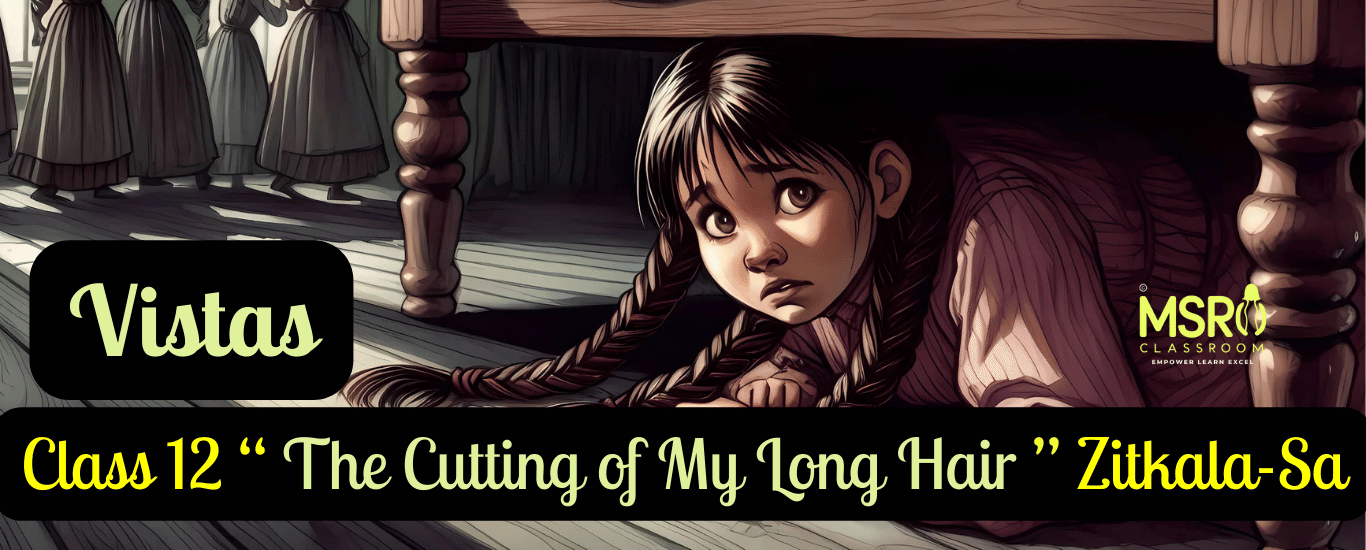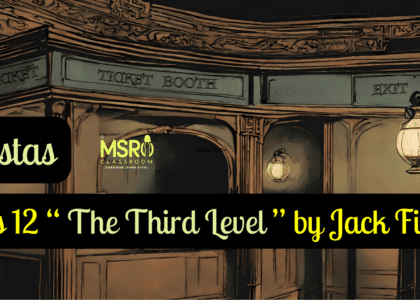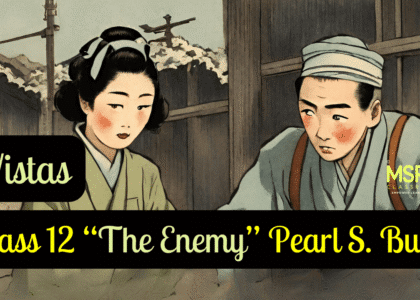Memories of Childhood, Part 1– “The Cutting of My Long Hair” by Zitkala-Sa , Summary, Theme, Extra Questions and Textbook Question and Answers.
Memories of Childhood
Part I- ‘The Cutting of My Long Hair’ by Zitkala-Sa
Table of Contents
Also Read: Part 2 “We Too Are Human Beings” by Bama
Summary- Part I ‘Memories of Childhood’- The Cutting of My Long Hair:
In Part I, ‘The Cutting of My Long Hair,’ Zitkala-Sa (Gertrude Simmons Bonnin)recounts her first day at a Native American boarding school. She describes the disorienting environment and the clash of cultures as she and other girls are introduced to the harsh rules of the school.
The pivotal moment comes when Zitkala-Sa learns that their long hair, a symbol of their culture, will be cut. In spite of her objections, she is subdued and forced to have her hair cut in a shingle style, representing the erosion of her cultural identity due to the assimilation policies of that era.

SHOP: MSRO SMART NOTES: Class 12 English Literature
Theme:
Cultural Oppression and Resistance:
Part 1, ‘The Cutting of My Long Hair’ by Zitkala-Sa, explores the themes of cultural identity, oppression, and resistance. It portrays the struggles of Native American children forced into assimilation at boarding schools and the traumatic experience of having their cultural identity stripped away.
The excerpt also highlights the themes of resistance and defiance in the face of oppression as Zitkala-Sa rebels against forced assimilation. The autobiographical account sheds light on the profound impact of colonialism and cultural assimilation on indigenous communities.
We highly recommend watching the following video!
Explanation for Auditory Learners:
Duration: 12 minutes
Time stamps and English subtitles available:
Character Sketch:
Zitkala Sa (Gertrude Simmons Bonnin):
Zitkala Sa, whose real name was Gertrude Simmons Bonnin, was a remarkable Native American woman born in 1876. Here’s a character sketch based on her life and the autobiographical account provided in the textbook:
- Strong-willed and Determined: Zitkala-Sa exhibited strong determination and resilience from a young age. Despite facing immense challenges and cultural oppression, she remained steadfast in her commitment to preserving her Native American identity and heritage.
- Culturally Rooted: Zitkala-Sa had a deep connection to her Native American heritage and traditions. Her upbringing instilled in her a profound respect for her cultural beliefs, language, and customs, which she courageously sought to uphold amidst the pressures of assimilation.
- Intellectually Gifted: Zitkala-Sa was a bright and curious individual who became a skilled writer and advocate for Native American rights. Her writings reflected her deep understanding of the social and political issues affecting Native communities.
- Resilient Survivor: Zitkala-Sa endured numerous hardships throughout her life, including forced assimilation at boarding schools and the systemic discrimination faced by Native Americans during the late 19th and early 20th centuries. Despite these challenges, she persevered with courage and resilience, using her voice and platform to raise awareness and advocate for change.
- Trailblazing Activist: Zitkala-Sa was a trailblazing activist and leader who challenged stereotypes, combated prejudice, and empowered Indigenous peoples to reclaim their rights and cultural heritage through her writings and advocacy work.
- Cultural Ambassador: Zitkala-Sa acted as a cultural ambassador, promoting cross-cultural understanding and paving the way for greater recognition of Native American contributions to American society.
Zitkala-Sa’s character embodies courage, resilience, intellect, and a deep commitment to preserving Native American culture and advancing social justice. Her life and legacy inspire generations of Indigenous activists and advocates striving for equality and empowerment.

SHOP: MSRO SMART NOTES: Class 12 English Literature
Extra Questions- Part I “Memories of Childhood”:
Shorter Answer Type Questions:
Q1: How does Zitkala-Sa describe her first day in the land of apples?
A1: Zitkala-Sa describes her first day as bitter-cold, filled with harsh noises and a sense of confinement. The surroundings were unfamiliar, and the experience was overwhelming for her sensitive spirit.
Q2: What does the cutting of Zitkala-Sa’s long hair symbolise in the context of her Native American identity?
A2: The cutting of Zitkala-Sa’s long hair symbolises the erasure of her Native American identity. In her culture, long hair held significance, and its forced removal represented the imposition of Western norms and cultural suppression.
Q3: How does Zitkala-Sa resist the cultural assimilation imposed upon her?
A3: Zitkala-Sa resists cultural assimilation by attempting to escape and hide when she learns about the impending cutting of her hair. Despite her efforts, she is forcibly restrained and subjected to the traumatic experience.
Q4: What cultural beliefs and practices regarding hair does the narrator express?
A4: The narrator expresses her cultural beliefs that long hair signifies bravery among her people and that only captured warriors have their hair shingled. She also highlights the significance of short hair for mourners and the symbolism of hair length among her community.
Q5: How does the narrator’s understanding of cultural norms clash with the expectations of the boarding school?
A5: The narrator’s understanding of cultural norms clashes with the expectations of the boarding school, where she is confronted with unfamiliar customs and practices. For example, the school’s requirement to shingle her long hair contradicts her cultural belief that it signifies bravery.
Q6: What emotions and thoughts does the narrator experience as she witnesses the cutting of her hair?
A6: During the cutting of her hair, the narrator experiences profound emotional distress, including anguish, sorrow, and a sense of powerlessness. She reflects on the loss of her cultural identity and yearns for the comfort and support of her mother.
Q7: How does the narrator’s experience at the boarding school reflect broader themes of colonialism and cultural assimilation?
A7: The narrator’s experience at the boarding school reflects broader themes of colonialism and cultural assimilation, where indigenous children were forcibly removed from their communities and subjected to Western education and cultural erasure. The cutting of her hair symbolises the suppression of indigenous identity and autonomy.
Q8: What role does the narrator’s friend, Judewin, play in the story, and how does their relationship contribute to the theme of resistance?
A8: Judewin is a crucial ally, warning the narrator of the impending haircut and fostering resistance against cultural assimilation. Their friendship highlights the theme of communal strength as they unite to defy the erasure of their cultural identity in the face of oppressive circumstances.
Q9: What role does the concept of cultural identity play in the narrator’s resistance to the boarding school’s assimilation efforts?
A9: Cultural identity is central to the narrator’s resistance, as she views her long hair as a symbol of bravery and cultural heritage. The boarding school’s attempt to shingle her hair represents the erasure of her identity, compelling her defiance against assimilation.
Long Answer Type Questions:
Q1: How do the narrator’s interactions with other Indian girls at the boarding school contribute to her understanding of cultural resilience and solidarity?
A1: The narrator’s interactions with other Indian girls at the boarding school foster a sense of cultural resilience and solidarity amidst adversity. Despite diverse backgrounds, they share a common experience of cultural oppression and assimilation. Through their collective resistance and support for one another, they reaffirm their cultural identities and resilience in the face of erasure.
These interactions are a source of strength and validation, validating their shared experiences and cultural heritage. By standing together against the imposition of Western norms, they demonstrate the power of communal solidarity in preserving indigenous cultures and traditions.
Through their bonds of friendship and shared struggle, the narrator learns the importance of collective resistance and solidarity in navigating the challenges of cultural assimilation, fostering a deeper understanding of cultural resilience and solidarity among marginalised communities.
Q2: What parallels can be drawn between the narrator’s experience of cultural oppression and the experiences of marginalised communities in other historical and contemporary contexts?
A2: The narrator’s experience of cultural oppression resonates with the struggles of marginalised communities worldwide. Throughout history and in contemporary contexts, various groups have faced systematic efforts to suppress their cultural identities.
For instance, the forced assimilation policies imposed on indigenous peoples, like the narrator, mirror similar tactics used against minority groups globally. Whether through colonialism, slavery, or ethnic discrimination, marginalised communities have endured efforts to erase their languages, traditions, and ways of life.
The parallels extend to contemporary issues, such as cultural appropriation, discrimination, and unequal access to resources and opportunities. Thus, the narrator’s story reflects a broader pattern of oppression and resilience shared by marginalised communities across diverse historical and cultural landscapes.
Q3: How does cutting the narrator’s long hair symbolise the loss of cultural autonomy and the imposition of Western norms?
A3: Cutting the narrator’s long hair symbolises the loss of her cultural autonomy and the imposition of Western norms. In many indigenous cultures, long hair holds deep significance, representing a connection to one’s heritage, community, and identity.
By forcibly cutting her hair, the boarding school authorities strip the narrator of this symbol, erasing a vital aspect of her cultural identity. It signifies the dominance of Western values over indigenous traditions, reflecting broader patterns of cultural imperialism and colonialism.
The act of cutting her hair not only physically alters her appearance but also marks a psychological and emotional rupture, as she is coerced into conforming to alien standards of appearance and behaviour. Thus, the haircut becomes a poignant metaphor for the suppression and subjugation of indigenous cultures under colonial rule.
Q4: What impact does the boarding school environment have on the narrator’s emotional and psychological well-being, both during and after the incident of having her hair cut?
A4: The boarding school environment profoundly impacts the narrator’s emotional and psychological well-being, exacerbating feelings of isolation, trauma, and cultural alienation. During the incident of having her hair cut, the environment fosters a sense of powerlessness and betrayal, intensifying her emotional distress.
Post-haircut, the boarding school continues to serve as a site of psychological turmoil, where the narrator grapples with the aftermath of cultural erasure and loss. The oppressive atmosphere perpetuates feelings of alienation and invalidation, compounding her sense of displacement from her artistic roots and community.
This experience leaves lasting scars on her psyche, contributing to feelings of disconnection and identity crisis that persist long after the traumatic event, highlighting the enduring impact of cultural oppression on indigenous individuals’ emotional and psychological well-being.
Q5: How might the narrator’s story resonate with contemporary discussions and activism surrounding indigenous rights, cultural preservation, and historical trauma?
A5: The narrator’s story resonates deeply with contemporary discussions and activism surrounding indigenous rights, cultural preservation, and historical trauma. Her experience sheds light on the enduring legacy of colonialism and the ongoing struggle for indigenous autonomy and recognition.
In today’s context, her narrative highlights the importance of preserving indigenous cultures, languages, and traditions in the face of ongoing cultural assimilation and erasure. It serves as a powerful reminder of the intergenerational trauma inflicted upon indigenous communities by colonial policies and institutions. Her story inspires activism to address systemic injustices, advocating for land rights, language revitalisation, and cultural sovereignty.
By amplifying her voice and experiences, contemporary indigenous rights discussions are enriched and informed, fostering greater awareness, empathy, and solidarity in the fight for justice and cultural preservation.





